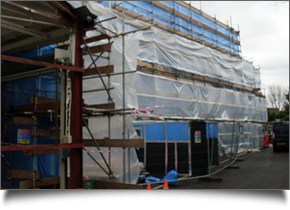Monitor the level and asbestos tape
After the asbestos, inspection has been carried out and its presence is confirmed, the transfer procedure begins. To stop the air particles that come out of the direct area, the space containing closed asbestos and negative air pressure is applied to it, which attracts the particles that fled back inside. Safety guidelines for the calling of asbestos for constant air monitoring, and if there is 0.02 asbestos fiber per milliliter of air detected, the transfer process must be stopped and reviewed – indications of how serious the threat is- click here for more information.
Wet asbestos disposal method
Like any dust or fiber, asbestos responds to muffled, and the wet transfer method is preferred, although there are cases where this is not possible. A good and low-pressure water spray is applied to the surface before being released and wetting substances such as detergent are added to help bind water to the fiber. This spray is applied to the material at the point where it is cut. In cases where asbestos is very thick so that the spray cannot reach far enough into the material, the saturation method is used where water is injected into the material through a series of holes.
Asbestos dust suction

You cannot use your household vacuum cleaners on asbestos, even if it is Dyson! Filters are not safe enough to contain all particles. Specialist companies hire asbestos vacuum cleaners because getting rid of the contents of vacuum cleaners is also a dangerous task. During the use of vacuum cleaners and the entire extraction process, the removal of asbestos must wear protective clothing made from dust fiber. Wool is not a suitable fiber, for example, because it traps dust. The coverall used during the transfer is disposable, but if they need to be reused, they must be sent to the commercial laundry for certain types of treatment.
Facilities for transfer of asbestos
There are three areas of contamination that need to be arranged at the transfer site: one ‘dirty’ and two ‘clean’. The dirty area, where the workers first leave when they appear from the tide, consists of shelves for shoes and clothing, waste bags to remove contaminated clothes, and bathing. The first clean area is where the respirators are stored, and contains other bath facilities, with negative airflow back to the dirty area. Finally, there is a second clean area where personal clothes and goods are stored. Entering or leaving the site, the transfer past these three phases.
Identify the existence of asbestos
The first step in protecting your health and your family, employees, or visitors to your site is to identify asbestos, and this is best done by an expert. Just seeing the wall for example is not enough to determine whether it contains asbestos.
Asbestos testing can include testing in places on your property, or testing can be done on the sample that you have collected safely and sent to the laboratory. Although you can collect your sample, one of the problems with this approach is that an inspector who meets the requirements of knowing what ingredients will be tested – may not occur by you that asbestos can be present in sealants for example. You also have to make sure the inspector you choose uses the accredited lab.
Although asbestos generally does not pose health risks unless it has been disturbed, it is important to realize exactly the area of your home or office that contains asbestos. This is very important if emergency repairs or maintenance are needed – Able to determine the existence and location of asbestos for workers will eliminate unexpected health risks and the possibility means that improvements will be resolved faster and more efficiently.

